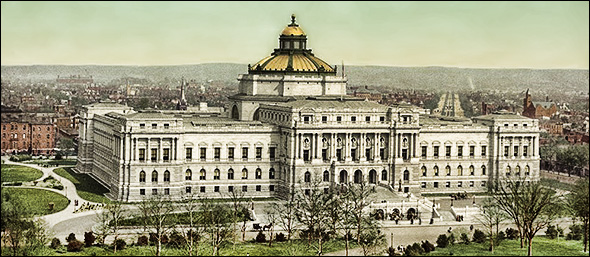Happy birthday, LOC!
It is, to a genealogist, about the happiest provision ever to be encountered in a statute book.
It’s in section 5 of a law signed by President John Adams 219 years ago today — and that section read:
And be it further enacted, That for the purchase of such books as may be necessary for the use of Congress at the said city of Washington, and for fitting up a suitable apartment for containing them and for placing them therein, the sum of five thousand dollars shall be, and hereby is appropriated ; and that the said purchase shall be made by the Secretary of the Senate and the Clerk of the House of Representatives, pursuant to such directions as shall be given, and such catalogue as shall be furnished by a joint committee of both houses of Congress to be appointed for that purpose ; and that the said books shall be placed in one suitable apartment in the capitol in the said city, for the use of both houses of Congress and the members thereof, according to such regulations as the committee aforesaid shall devise and establish.1
You know what that means, right? That’s the law that officially began the history of an institution described by Pamela Boyer Sayre as “Our National Treasure.”2

It’s the Library of Congress, “an unparalleled world resource” holding “more than 168 million items includ(ing) more than 39 million cataloged books and other print materials in 470 languages; more than 72 million manuscripts; the largest rare book collection in North America; and the world’s largest collection of legal materials, films, maps, sheet music and sound recordings.”3 It’s the largest library in the world, and “(e)ach working day the Library receives some 15,000 items and adds more than 10,000 items to its collections.”4
It’s where you’ll find The Legal Genealogist‘s favorite web resource, A Century of Lawmaking for a New Nation, and favorite legal blog, In Custodia Legis, and favorite place to find images that are generally free of copyright restrictions, and favorite map collections, and…
Oh my.
It’s easy to get carried away with the goodies at the Library of Congress.
Its history is rich: it was destroyed in 1814 when the British burned Washington and destroyed the U.S. Capitol building. Thomas Jefferson then offered to sell his own personal library — “the largest and finest in the country, to the Congress to ‘recommence’ its library. The purchase of Jefferson’s 6,487 volumes for $23,940 was approved in 1815.”5 The spectacular Jefferson Building, centerpiece of the modern Library of Congress, was opened to the public in 1897, although it didn’t get the Jefferson name until 1980.6
And its holdings — both digital and textual — are even richer.
There’s no way I can begin to outline what lies in the collections of the Library of Congress that a genealogist could use. Let me just note that, in the digital collections alone, there are:
• 116 collections focusing on American History including 16 on African American History and five on Women’s History.
• 84 collections focusing on Government, Law & Politics.
• 67 collections focusing on War & Military.
• 50 collections focusing on Local History & Folklife.
• 28 collections focusing on Social & Business History.
• 27 collections focusing on Geography & Places.
And that doesn’t even touch on the dozens of collections of prints and photographs we can freely use in our work. Portraits. Glass Negatives. Cityscape Photographs. Cartoons (Commentary).
Nor does it mention the astounding collection of digitized newspapers called Chronicling America: Historic American Newspapers.
Those are just a few of the digital collections. What’s there at the Library to be used in person — that’s all of this and so much more.
All begun 219 years ago today, with one section of one federal law, and an allocation of $5,000 for “such books as may be necessary…”
Happy birthday, Library of Congress!! And many, many, many happy returns of the day.
Cite/link to this post: Judy G. Russell, “Such books as may be necessary,” The Legal Genealogist (https://www.legalgenealogist.com/blog : posted 24 Apr 2019).
SOURCES
Image: “The Library of Congress,” Washington, Detroit Photographic Co. (1902); Library of Congress Prints & Photographs Division.
- §5, An Act to make further provision for the removal and accommodation of the Government of the United States, 2 Stat. 55, 56 (24 Apr 1800). ↩
- Pamela Boyer Sayre, “Our National Treasure: The Library of Congress,” presentation, NGS 2009 Conference, The Building of a Nation: From Roanoke to the West. ↩
- Library of Congress, “General Information: Collections,” About the Library (https://www.loc.gov : accessed 24 Apr 2019). ↩
- Ibid., “Fascinating Facts.” ↩
- John Y. Cole, “The Library of Congress, 1800-1992,” Jefferson’s Legacy: A Brief History of the Library of Congress, online edition, LOC.gov (http://www.loc.gov/loc/legacy/toc.html : accessed 24 Apr 2019). See also “An act to authorize the purchase of the library of Thomas Jefferson, late President of the United States,” 3 Stat. 195 (30 Jan 1815). ↩
- Library of Congress, “History of the Library of Congress,” About the Library (https://www.loc.gov : accessed 24 Apr 2019). ↩



There was a great webinar yesterday, April 23, that was recorded, in which much of the digital portion of the site was covered. I haven’t found the recording (loc is huge!) yet, but it will probably be posted soon.
Here is the link. http://login.icohere.com/vploc?pnum=GNG65349
You must be on a laptop or desktop.
What timing. I had just finished writing an article about Carla Hayden, Librarian of Congress, for my DAR Chapter newsletter. I included some of the very interesting history of LOC.